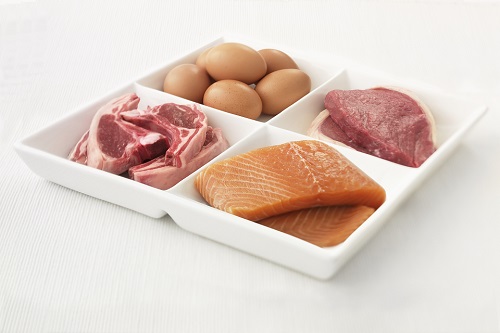Back to Basics: Increasing Protein Intake on Dialysis

Protein is an important nutrient that can help our bodies fight off infection, heal wounds, build muscles and increase energy. It is especially important for dialysis patients to eat plenty of protein, as some protein is lost during each dialysis treatment.
To assess protein intake, albumin levels are tracked in dialysis patients. Albumin is a type of protein in the blood that serves as a marker for a patient’s nutritional status. In dialysis patients, the desired range is 4.0 g/dL or greater. A level under 4.0 g/dL may indicate protein intake is inadequate. Low albumin may also be a marker for inflammation.
Protein Sources
Good protein sources include eggs, meat (beef, pork, poultry), fish, shellfish and some dairy products such as cottage cheese or Greek yogurt. A general recommendation for dialysis patients is to consume 8 to 10 ounces of protein per day. When estimating protein portions, 3 ounces of meat is approximately the same size as a deck of cards. Protein can also be found in plant-based sources including soy products like tofu and tempeh. There are newer plant-based proteins that look and taste like ground meat. However, these products are highly processed and may contain a significant amount of sodium. Legumes and nuts are also good protein sources; however, these foods are also higher in potassium and phosphorus. Ask your dietitian if including plant-based protein sources would be a good fit for you.
Tips to Increase Protein Intake
- Add a protein-rich snack or two. Some high-protein snack ideas include cottage cheese, crackers with tuna or hard boiled eggs.
- Consider trying a protein supplement. Ask your dietitian whether a protein supplement would be beneficial for you. There are many options available to fit a variety of taste preferences including protein shakes, protein bars and protein powders.
- Eat protein foods first at each meal. Make protein your priority and eat your protein foods before you have the chance to get full.
- Include a protein source with each meal. Including approximately 3 ounces of protein with each meal can help you achieve your protein intake goals.
- Introduce some variety. Try switching up your protein sources or trying a new protein-rich recipe. Check out DaVita.com for ideas or try one of these tasty recipes to help boost your protein intake:

- Sheet Pan Chicken with Green Beans and Potatoes
- Easy Crock-Pot Beef Stroganoff
- Easy Turkey Sloppy Joes
References:
- https://www.dpcedcenter.org/news-events/news/albumin-and-chronic-kidney-disease/ Access date: July 22, 2021
- https://www.kidney.org/atoz/content/dietary_hemodialysis Access date: July 21, 2021
- https://www.kidney.org/atoz/content/getting-more-protein-while-dialysis Access date: July 21 2021
Additional Kidney Diet Resources
Visit DaVita.com and explore these diet and nutrition resources:
- DaVita Food Analyzer
- DaVita Dining Out Guides
- Today’s Kidney Diet Cookbooks
- DaVita Kidney-Friendly Recipes
- Diet and Nutrition Articles
- Diet and Nutrition Videos
- Kidney Smart® Virtual Classes
This article is for informational purposes only and is not a substitute for medical advice or treatment. Consult your physician and dietitian regarding your specific diagnosis, treatment, diet and health questions.

Recent Comments